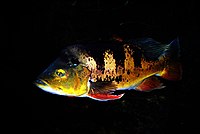
Photo from wikipedia
Human activities and the consequent extirpations of species have been changing the composition of species assemblages worldwide. These anthropogenic impacts alter not only the richness of assemblages but also the… Click to show full abstract
Human activities and the consequent extirpations of species have been changing the composition of species assemblages worldwide. These anthropogenic impacts alter not only the richness of assemblages but also the biological dissimilarity among them. One of the main gaps in the assessment of biodiversity change in freshwater ecosystems is our limited understanding regarding how taxonomic and functional facets of macrophyte assemblages respond to human impacts on regional scales. Here, we assess the temporal (before 1970s against after 2000s) changes in taxonomic and functional richness and compositional dissimilarities, partitioned into its turnover and nestedness components, of freshwater macrophyte assemblages across the floodplain lakes of the Yangtze River in China. We found that functional and taxonomic assemblage differentiation occurred simultaneously under increasing human impact, concomitant to a general decrease in functional and taxonomic richness. However, this effect weakened when the historical level of taxonomic dissimilarity among assemblages was high. Macrophyte species with large dispersal range and submersed life form were significantly more susceptible to extirpation. The impact of human activities on differentiation was complex but habitat loss and fishery intensity were consistently the main drivers of assemblage change in these lakes, whereas water quality (i.e., light pollution and nutrient enrichment) had weaker effects. Further, macrophyte taxonomic and functional differentiation was mainly driven by the nestedness component of dissimilarity, accounting for changes in assemblage composition related to changes in species richness independent of species replacement. This result, markedly different from previous studies on freshwater fish assemblages conducted in these lakes, represents a novel contribution toward achieving a more holistic understanding of how human impacts contribute to shape community assemblages in natural ecosystems.
Journal Title: Frontiers in Plant Science
Year Published: 2018
Link to full text (if available)
Share on Social Media: Sign Up to like & get
recommendations!